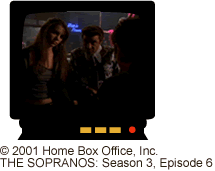|
Lisa Johnson, "The Stripper as Resisting Reader: Stripper Iconography and Sex Worker Feminism on The Sopranos"
(page 2 of 4)
 Throughout this episode, two stories are carefully interwoven. One
narrative strand follows Tracee, a dancer at the Bada Bing! club, as she
attempts to create a traditional family dynamic in her life. In the
opening scene she approaches Tony with a gift of homemade date-nut
bread, and later she entertains hyperreal fantasies of a future home
life with Ralphie, the volatile gladiator-wannabe whose baby she is
carrying. Her fantasies measure the extreme distortions produced by
immersion in the ideology of family values, as she imagines their life
as suburban, normal, loving, tidily poised at the end curve of a New
Jersey cul-de-sac. Her actual experiences of the nuclear family
as a violent space (her mother burned her hand on the stove when she was
a child, and she repeats the act by burning her infant son with
cigarettes) are erased by this media-driven nostalgia for home. The
second narrative strand follows Meadow, Tony's daughter, as she
negotiates her first year at college. Meadow is sorting through romantic
mythologies and imperfect relationship realities as she pursues sexual
pleasure while trying to gauge her boyfriend's commitment and
trustworthiness. Her loss of virginity works as a counterplot to
Tracee's quest for domesticity. The "good" daughter becomes sexualized,
as the "bad" stripper seeks the legitimacy of love, marriage, and baby
carriage.
Throughout this episode, two stories are carefully interwoven. One
narrative strand follows Tracee, a dancer at the Bada Bing! club, as she
attempts to create a traditional family dynamic in her life. In the
opening scene she approaches Tony with a gift of homemade date-nut
bread, and later she entertains hyperreal fantasies of a future home
life with Ralphie, the volatile gladiator-wannabe whose baby she is
carrying. Her fantasies measure the extreme distortions produced by
immersion in the ideology of family values, as she imagines their life
as suburban, normal, loving, tidily poised at the end curve of a New
Jersey cul-de-sac. Her actual experiences of the nuclear family
as a violent space (her mother burned her hand on the stove when she was
a child, and she repeats the act by burning her infant son with
cigarettes) are erased by this media-driven nostalgia for home. The
second narrative strand follows Meadow, Tony's daughter, as she
negotiates her first year at college. Meadow is sorting through romantic
mythologies and imperfect relationship realities as she pursues sexual
pleasure while trying to gauge her boyfriend's commitment and
trustworthiness. Her loss of virginity works as a counterplot to
Tracee's quest for domesticity. The "good" daughter becomes sexualized,
as the "bad" stripper seeks the legitimacy of love, marriage, and baby
carriage.
This parallel is deliberately crafted through twinned scenes and
rhetorically pointed segues in which Meadow's body fades into Tracee's.
In one scene Meadow and her mother, Carmela, have a conversation about
Meadow's biracial boyfriend. Carmela asks her daughter if she is in love
with Noah. Meadow responds, "At this point I'd better be." Carmela asks,
"At what point?" Meadow demurs, "We are so not having that
conversation." In a previous scene we see Meadow under Noah as he
unwraps a condom. Meadow is clearly referring to the birds-and-bees
conversation that makes for such predictable humor in family television.
In her most sardonic teenage knowingness, Meadow is not "going there"
with Carmela, resisting the possibility of warm bonding, Gilmore
Girls style. In the next scene, we see Tracee talking with Tony,
reproducing the daughter/parent dyad of Meadow and Carmela, but instead
of taking place in the cozy bedroom of the family home, this
conversation happens outside the strip club, in the alienated space of a
gravel parking lot. Where the Meadow/Carmela scene subverts our
expectations for closeness, the Tony/Tracee scene parodies them in
grotesque form. Tracee tells Tony she is pregnant, and that it is
Ralphie's baby. She is positioned in relation to Tony in this scene as a
daughter figure, seeking advice and support, but as an unwed mother and
a sex worker, she takes on the hybrid role of deviant daughter, doubling
Meadow's newly deflowered status.
These blurred boundaries between stereotypes enact the
poststructuralist dictum that each pole is haunted and inflected by its
supposed opposite. Tracee and Meadow hold within their separate social
roles traces of the other, calling the good girl / bad girl
binary of traditional Western thought directly into question. This move
aligns the episode with the concerns of sex worker feminism. Jill Nagle,
in Whores and Other Feminists, reminds her readers of a commonly
noted point in sex radical feminism, that the whore stigma affects all
women, shaping how we perceive and present ourselves. We must "not only
be virtuous, but also . . . appear virtuous, to . . .
demonstrate our affiliation with the privileged half of the good girl /
bad girl binary" (5). The parallel between Tracee and Meadow dismantles
this tenacious binary, constructing portraits of young women in the
space between categories and asking, to borrow Nagle's language, "what
purposes are served by using any sexual categories to describe
women" (4). Tracee's status as whore seems to make her vulnerable to
attack (Ralphie mentions it several times to excuse himself for killing
her), but Tony recognizes Tracee and Meadow as the same, not as
opposites. In the following episode Tony looks at Meadow and sees
Tracee, suggesting that there is no "particular class of woman" (to
paraphrase playwright Janet Feindel) who is suited to
stripping or who is less deserving of safety and sexual freedom
[2].
|